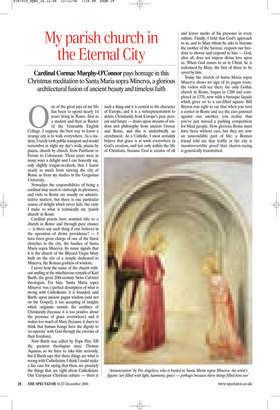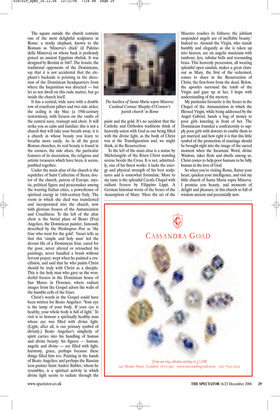My parish church in the Eternal City
Cardinal Cormac Murphy-O’Connor pays homage in this Christmas meditation to Santa Maria sopra Minerva, a glorious architectural fusion of ancient beauty and timeless faith One of the great joys of my life has been to spend nearly 14 years living in Rome, first as a student and then as Rector of the Venerable English College. I suppose the best way to know a strange city is to walk everywhere. As a student, I rarely took public transport and would remember at night my day’s walk, piazza by piazza, church by church, from Pantheon to Forum to Colosseum. Those years were in many ways a delight and I can honestly say, only slightly tongue-in-cheek, that I learnt nearly as much from viewing the city of Rome as from my studies in the Gregorian University.
Nowadays the responsibilities of being a cardinal may seem to outweigh its pleasures, and visits to Rome are usually on administrative matters; but there is one particular source of delight which never fails: the visits I make to what is technically my ‘parish church’ in Rome.
Cardinal priests have nominal title to a church in Rome and through pure chance — is there any such thing if one believes in the operation of divine providence? — I have been given charge of one of the finest churches in the city, the basilica of Santa Maria sopra Minerva. Its name signals that it is the church of the Blessed Virgin Mary built on the site of a temple dedicated to Minerva, the Roman goddess of wisdom.
I never hear the name of the church without smiling at the mischievous remark of Karl Barth, the great 20th-century Swiss Calvinist theologian. For him, ‘Santa Maria sopra Minerva’ was a perfect description of what is wrong with Catholicism: it is founded, said Barth, upon ancient pagan wisdom (and not on the Gospel), is too accepting of insights which originate outside the confines of Christianity (because it is too positive about the presence of grace everywhere) and it makes too much of Mary (because it dares to think that human beings have the dignity to ‘co-operate’ with God through the exercise of their freedom).
Now Barth was called by Pope Pius XII the greatest theologian since Thomas Aquinas, so we have to take him seriously; but if Barth says that these things are what is wrong with Catholicism, I think I could make a fair case for saying that these are precisely the things that are right about Catholicism. Our European Christian culture — there is such a thing and it is central to the character of Europe, and it is a misrepresentation to delete Christianity from Europe’s past, present and future — draws upon streams of wisdom and philosophy from ancient Greece and Rome, and this is undoubtedly an enrichment. As a Catholic, I most certainly believe that grace is at work everywhere in God’s creation, and not only within the life of Christians, because God is creator of all and leaves marks of his presence in every culture. Finally, I hold that God’s approach to us, and to Mary whom he asks to become the mother of the Saviour, respects our freedom to choose and respond to him — God, after all, does not impose divine love upon us. When God comes to us in Christ, he is welcomed by Mary, the first of those to be saved by him.
Today the church of Santa Maria sopra Minerva shows no sign of its pagan roots: the visitor will see there the only Gothic church in Rome, begun in 1280 and completed in 1370, now with a baroque façade which gives on to a car-filled square. Bill Bryson was right to say that when you turn a corner in Rome and see the cars jammed against one another, you realise that you’ve just missed a parking competition for blind people. How glorious Rome must have been without cars, but they are now an unavoidable part of life; a Roman friend told me that traffic in the city is incontrovertible proof that chariot-racing is genetically transmitted. The square outside the church contains one of the most delightful sculptures in Rome: a stocky elephant, known to the Romans as ‘Minerva’s chick’ (il Pulcino della Minerva) on whose back is perilously poised an ancient Egyptian obelisk. It was designed by Bernini in 1667. The Jesuits, the traditional opponents of the Dominicans, say that it is not accidental that the elephant’s backside is pointing in the direction of the Dominican headquarters from where the Inquisition was directed — but let us not dwell on this rude matter, but go inside the church itself.
It has a central, wide nave with a double row of cruciform pillars and two side aisles; the ceiling is sky blue (a 19th-century restoration), with frescos on the vaults of the central nave, transept and choir. It will strike you as calm and familiar; this is not a church that will take your breath away; it is a church in whose beauty you learn to breathe more easily. As in all the great Roman churches, its real beauty is found in the corners, the side altars, the particular features of its decoration, the religious and artistic treasures which have been, it seems, jumbled together.
Under the main altar of the church is the sepulchre of Saint Catherine of Siena, doctor of the church, patron of Europe, mystic, political figure and peacemaker among the warring Italian cities, a powerhouse of spiritual energy in 14th-century Italy. The room in which she died was transferred and incorporated into the church, now with glorious frescos of the Annunciation and Crucifixion. To the left of the altar choir is the burial place of Beato (Fra) Angelico, the Dominican painter, famously described by the Washington Post as ‘the friar who went for the gold’. Vasari tells us that this ‘simple and holy man’ led the devout life of a Dominican friar, cared for the poor, never altered or retouched his paintings, never handled a brush without fervent prayer, wept when he painted a crucifixion, and said that he who paints Christ should be truly with Christ as a disciple. This is the holy man who gave us the wonderful frescos in the Dominican house of San Marco in Florence, where radiant images from the Gospel adorn the walls of the humble cells of the friars.
Christ’s words in the Gospel could have been written for Beato Angelico: ‘Your eye is the lamp of your body. If your eye is healthy, your whole body is full of light.’ To visit is to honour a spiritually healthy man whose eye was filled with divine light. (Light, after all, is our primary symbol of divinity.) Beato Angelico’s simplicity of spirit carries into his handling of human and divine beauty: his figures — human, angelic and divine — are filled with light, harmony, grace, perhaps because these things filled him too. Painting in the hands of Beato Angelico, and perhaps the Russian icon painter Saint Andrei Rublev, whom he resembles, is a spiritual activity in which divine light seems to radiate through the paint and the gold. It’s no accident that the Catholic and Orthodox traditions think of heavenly union with God as our being filled with the divine light, as the body of Christ was at the Transfiguration and, we might think, at the Resurrection.
To the left of the main altar is a statue by Michelangelo of the Risen Christ standing serene beside the Cross. It is not, admittedly, one of his finest works: it lacks the energy and physical strength of his best sculptures and is somewhat formulaic. More to my taste is the splendid Carafa Chapel with radiant frescos by Filippino Lippi. A German historian wrote of the fresco of the Assumption of Mary: ‘Here the art of the Maestro reaches its fullness; the jubilant suspended angels are of ineffable beauty.’ Indeed so. Around the Virgin, who stands humbly and elegantly as she is taken up into heaven, are six angelic musicians with tambour, lyre, tubular bells and resounding brass. This heavenly procession, all wearing splendid open sandals, makes a great clamour as Mary, the first of the redeemed, comes to share in the Resurrection of Christ, the first-born from the dead. Below, the apostles surround the tomb of the Virgin and gaze up at her, I hope with understanding of the mystery.
My particular favourite is the fresco in the Chapel of the Annunciation in which the Blessed Virgin, while being addressed by the Angel Gabriel, hands a bag of money to poor girls kneeling in front of her. The Dominicans founded a confraternity to supply poor girls with dowries to enable them to get married; and how right it is that this little symbol of the promotion of marriage should be brought right into the image of the sacred moment when the Incarnate Word, divine Wisdom, takes flesh and dwells among us. Christ comes to help poor humans to be fully human in the love of God.
So when you’re visiting Rome, flatter your heart, quicken your intelligence, and visit my little church of Santa Maria sopra Minerva. I promise you beauty, and moments of delight and pleasure, in this church so full of wisdom ancient and perennially new.







































































































































 Previous page
Previous page